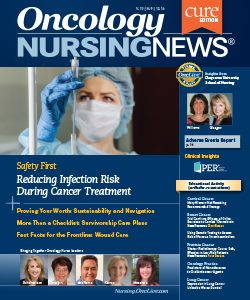Back to Basics: Spotlighting Safety in Oncology
OncLive Chairman, Mike Hennessy

OncLive Chairman,
Mike Hennessy
Nurses are the vanguard of so many aspects of delivering cancer treatment, perhaps nowhere more than in ensuring safety protocols are faithfully followed. This applies not only when patients are in the hospital but when they go home.
This issue of Oncology Nursing News takes a close look at some of the potential safety landmines that need to be top of mind for the oncology nursing professional. I admit that I was surprised to learn that the vast majority of septic infections—nearly 80%—begin outside the hospital.
In our cover story this month, we hear from nurse experts on how clinicians can help avoid this life-threatening complication—not only by employing best practice themselves, but by arming their patients with the education and information they need to continue their therapies safely and effectively when they get home.
We also hear from nurses who had cancer themselves—one who witnessed firsthand how a nurse well-trained in proper venous access procedures can make all the difference in reducing the risk of infection. Another nurse diagnosed with breast cancer had a very close call when after she was discharged, she contracted a staph infection from an infected port.
In that vein, the NCCN has just launched a “Just Bag It” campaign to underscore the critical importance of minibag administration of the chemotherapy drug vincristine, and Editor-in-Chief Lisa Schulmeister urges her peers to make sure the facilities where they work are in compliance with this life-saving protocol. And, in “Fast Facts for the Frontline” this month, the focus is on wound care issues which oncology nurses are likely to encounter, such as those resulting from surgical incisions or radiation burns.
Also in this issue, we learn more about why building an evidence base is so important to obtaining leadership buy-in for nurse-led navigation and survivorship care initiatives. You know these programs improve patient outcomes and quality of life, but in today’s environment their value must be documented for administrators and payers. This, the experts featured in this issue remind us, means that nurses must add a business mindset to their all-important clinical focus when working to establish and sustain navigation and survivorship programs where they work.
Finally, during this holiday season, we hope you will have some time to pause, recharge, and relax with your families and friends. We extend our very best wishes for the holidays and the new year, and as always, thank you for reading.
—Mike Hennessy
Chairman and CEO

Innovative Program Reduces Nurse Turnover and Fosters Development
Published: September 12th 2024 | Updated: September 12th 2024The US Oncology Network (The Network) has developed one of the most comprehensive programs in the nation to support the professional development and retention of new oncology nurses.


